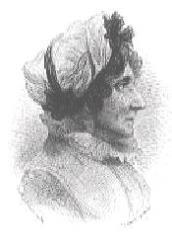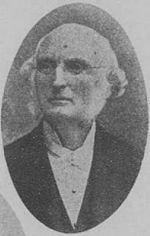Planning worship?
Check out our sister site, ZeteoSearch.org,
for 20+ additional resources related to your search.
- |
User Links
Person Results
Joseph P. Holbrook
1822 - 1888 Composer of "CHURCH" in Book of Worship with Hymns and Tunes Joseph P. Holbrook was a tune writer in the parlor music style, and used the popular melodies of Mason and Hastings, Bradbury and Root, Greatorex and Kingsley in his collections. He furnished settings for the choir hymns in Songs for the Sanctuary in his Quartet and chorus Choir (New York, 1871, and sought more recogniation than had been given him in a hymnal of his own, Worship in Song (New York, 1880); a book that found no welcome.
from The English hymn: its development and use in worship
By Louis FitzGerald Benson
Joseph P. Holbrook
Anna L. Barbauld

1743 - 1825 Author of "Our country is Immanuel's ground" in Book of Worship with Hymns and Tunes Barbauld, Anna Laetitia, née Aikin, daughter of the Rev. John Ailrin, D.D., a dissenting minister, was b. at Kibworth-Harcourt, Leicestershire, June 20, 1743. In 1753 Dr. Aikin became classical tutor at a dissenting academy at Warrington. During her residence there she contributed five hymns to Dr. W. Enfield's Hymns for Public Worship, &c, Warrington, 1772. In the following year these were included in her Poems, Lond., J. Johnson, 1773. In May, 1774, Miss Aikin was married to the Rev. Rochemont Barbauld, a descendant of a French Protestant family, and a dissenting minister. For some years Mr. Barbauld conducted, in addition to his pastoral work, a boarding school at Palgrave, Suffolk. From this he retired in 1785. In 1786 he undertook the charge of a small congregation at Hampstead, and from thence he passed to the dissenting chapel (formerly Dr. Price's) at Newington Green, in 1802. He d. Nov. 11, 1808. Mrs. Barbauld continued to reside in the neighbourhood until her death, March 9, 1825. In the latter part of the same year her niece published The Works of Anna Laetitia Barbauld, with Memoir, by Lucy Aikin, 2 vols., Lond., Longman, 1825. As a writer of hymns Mrs. Barbauld was eminently successful. Their use, however, with the exception of five contributed to Dr. W. Enfield's collection, is almost exclusively confined to the Unitarian hymnals of Great Britain and America. Including these hymnals, the whole of her hymns are still in common use. These hymns appeared thus:—
i. In Dr. W. Enfield's Hymns, &c., 1772.
1. Again the Lord of life and light. Easter.
2. Awake, my soul, lift up thine eyes. Conflict.
3. Behold, where breathing love divine. Christian Charity.
4. Jehovah reigns, let every nation hear. God's Dominion. A part of this was given in Collyer's Sel., 1812, No. 586, as:—
5. This earthly globe, the creature of a day.
6. Praise to God, Immortal praise. Harvest.
ii. Poems, 1773 (Preface dated Dec. 1, 1772). The whole of the above, and also:—
7. God of my life and author of my days. To God the Father. This is an “Address to the Deity," in 80 1. It is given in Martineau's Collection, 1840 and 1873. From it the following centos were given in Collyer's Selection> 1812:—
8. God, our kind Master, merciful as just.
9. If friendless in the vale of tears I stray.
iii. Poems revised 1792.
10. Come, said [says] Jesus' sacred voice. Invitation.
11. How blest the sacred tie that binds. Christian Fellowship.
12. Lo where a crowd of pilgrims toil. Pilgrimage of Life. From this is taken:—
13. Our country is Immanuel's ground [land].
iv. Leisure Hour Improved (Ironbridge), 1809.
14. Sweet is the scene when virtue dies. Death.
v. Supplement to the Unitarian Coll. of Kippis, Bees, and others, 1807.
15. When as returns the solemn day. Sunday.
16. Sleep, sleep to day, tormenting cares. Sunday.
17. How may earth and heaven unite. Worship.
vi. Works, with Memoir, 1825.
In vol. i. most of the above are reprinted, and the following are added :—
18. Joy to the followers of the Lord. Joy. (c. 1820.)
19. Pure spirit, O where art thou now. Bereavement. This is dated 1808.
20. Salt of the earth, ye virtuous few. Salt of the Earth.
21. When life as opening buds is sweet. Death. This is dated " November, 1814."
The more important of these hymns are annotated in this Dictionary under their first lines. Mrs. Barbauld's Hymns in Prose for Children, originally published in 1781, were long popular and have been translated into French, Italian, Spanish, and other languages.
-- John Julian, Dictionary of Hymnology (1907)
===================
Barbauld, Anna L., p. 113, ii. No. 18 on p. 114, i.,should be dated circa 1820. Another hymn in common use from Mrs. Barbauld's Works, &c, 1825, is, "O Father! though the anxious fear" (E. Taylor, p. 1117, in error).
--John Julian, Dictionary of Hymnology, Appendix, Part II (1907)
See also in:
Hymn Writers of the Church
Anna L. Barbauld
Samuel R. Brown

1810 - 1880 Person Name: S. R. Brown Composer of "MONSON" in Book of Worship Samuel Robbins Brown (16 June 1810-20 June 1880) was an American missionary to China and Japan with the Dutch Reformed Church.
Brown was born in Connecticut, graduated from Yale in 1832, studied theology in Columbia, South Carolina, and taught for four years (1834–38) in the New York Institution for the Deaf and Dumb.
In 1838 he went to Guangzhou and opened, for the Morrison Education Society, the first Protestant School in the Chinese Empire—a school in which were taught Yung Wing and other pupils who afterward came to the United States. The several annual reports on this school were published in The Chinese Repository for 1840 to 1846, to which he contributed some of his papers on Chinese subjects.
After nine years' service, his wife's health failing, Brown returned to the United States and became a pastor at Sand Beach Church and teacher of boys at Owasco Outlet, near Auburn (1851–59). He worked for the formation of a college for women, which was situated first in Auburn and then in Elmira, New York and now known as Elmira College. Brown was responsible for sponsoring Yung Wing (1828-1912); the first Chinese student to graduate from a U.S. university, graduating from Yale College in 1854.
When by the Townsend Harris treaty of 1858, Yokohama and Nagasaki in Japan were opened to trade and residence, Brown sailed for the former port and opened a school in which hundreds of young men, afterwards leaders in various walks of life, were educated. He translated the New Testament, and taught and preached for 20 years. He was one of the founders of the Asiatic Society of Japan and in many ways one of the most prominent makers of the new Japan. He returned to the United States in 1867 following a fire that destroyed his home, library, manuscripts, and notes.
Brown died during his sleep, while visiting an old friend in Stockbridge, Massachusetts, and is buried at Monson, Massachusetts, his boyhood home.
--en.wikipedia.org/wiki/
Samuel R. Brown


 My Starred Hymns
My Starred Hymns


